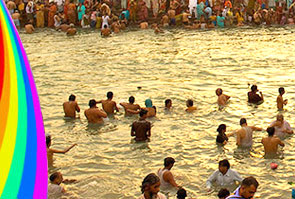Kumbh Mela is a religious event that is organized on
a grand scale in India. Kumbh Mela has a lot of significance for people
in India, as it gives them an opportunity to liberate themselves from
the sufferings and wash away all their sins. Kumbh Mela is believed to
have the largest congregation of ascetics, yogis, sadhus, sages and
common men living on the planet Earth. People from all across the
country assemble here to observe this famous Mela, but very few are
aware about its origin & history.
There are many interesting legends about the origin and celebration of
the Kumbha Mela. The story revolves around the fight between demons and
Gods for the nectar of immortality. The origin of Kumbh Mela can be
traced back to the Vedic period, when the deities and demons arrived at
a consensus to work together in the task of churning "amrit",
i.e. the nectar of immorality from the Ksheera Sagara (the primeval
ocean of milk). It was decided that the nectar would be shared amongst
all on an equal basis. To know the complete story, read further.
When the Kumbh or the pitcher full of amrit appeared, the demons played
a mischief and they escaped the place with the nectar. The Gods also
followed them and fought with demons in the sky for acquiring the
pitcher of amrit. The battle went on for twelve consecutive days and
nights, which was equivalent to 12 human years. It is said that during
the war, a few drops of amrit fell on the earth at four distinctive
spots, namely Prayag, Haridwar, Ujjain and Nasik. These are those four
points or locations, where Kumbh Mela festival is celebrated four times
in every 12 years.
The history and origin of Kumbh Mela can be
traced back to the Vedic period. Check out the legends about the
Kumbh Mela festival.
Colors of India: Kumbh Mela : Kumbh Mela
History







